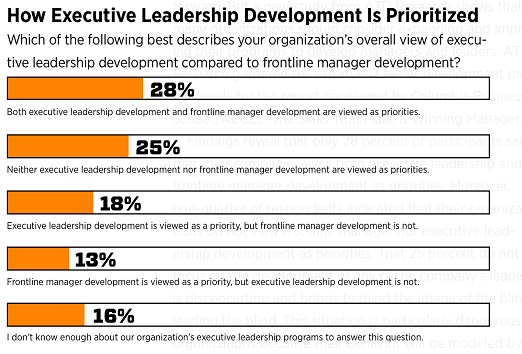CTDO Magazine Article
The Blind Leading the Blind
Not enough organizations develop leaders at all levels.
Thu Dec 15 2016

Those in leadership and management positions in organizations are responsible for setting the tone in their companies and making sure all employees are driving the business forward. But a new study from ATD Research shows that many organizations should consider expanding and improving their programs to develop managers and leaders. ATD Research gathered data from 847 talent development professionals for the report sponsored by Columbia Business School, ACCEL: The Skills That Make a Winning Manager.
Findings reveal that only 28 percent of participants said that their companies view both executive leadership and frontline manager development as priorities. Moreover, one-quarter of respondents indicated that their organizations do not view frontline manager nor executive leadership development as priorities. That 25 percent do not focus on the development of any of the company's leaders is disconcerting and brings to mind the image of the blind leading the blind. This situation is particularly dangerous for organizations because their behavior will be modeled by others, and unfit supervisors can cause workers to become disengaged or quit.
Just less than one-third of participants indicated that their organizations prioritize development of one group but not the other. For example, 18 percent of respondents said that executive training is prioritized at their organizations, but the development of frontline management is not. This is troubling because employees are only developed after they reach the highest ranks of the organization, when specific habits already may be ingrained. Furthermore, the behavior of frontline managers certainly can affect the culture and tone of an organization, so failure to develop this group has immediate consequences in addition to long-term ones.

Meanwhile, 13 percent reported that their company prioritizes frontline manager development but not executive leadership development. This implies that once managers have gone through the training, if they make it to the highest ranks of an organization, development may be treated as no longer needed. This also could present a problem when outside executives are hired because they might be unlikely to get necessary training.
At organizations where frontline manager development is prioritized, it's possible that learning is viewed as a one-time event rather than an ongoing process with reinforcement throughout one's tenure. However, this viewpoint can be dangerous. Some skills, such as emotional intelligence (EQ), actually decline in senior leaders. EQ entails recognizing one's own and others' emotions and using emotional information to guide one's behavior and thoughts.
As Travis Bradberry, president of TalentSmart and co-author of Emotional Intelligence 2.0, explains, "EQ increases with age, so younger people tend to have lower EQ scores on average. The trick is, we also find that emotional intelligence scores drop amongst senior leadership; it peaks in middle managers. So senior leaders need training, as well, regardless of their age."
As talent development professionals, it's important to remember that training is necessary for all levels of leadership. Therefore, continuing training throughout one's journey up the ranks of leadership in an organization is essential to keep the workforce engaged and productive.
Read more from CTDO magazine: Essential talent development content for C-suite leaders.
